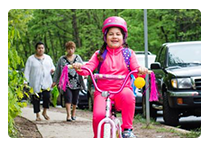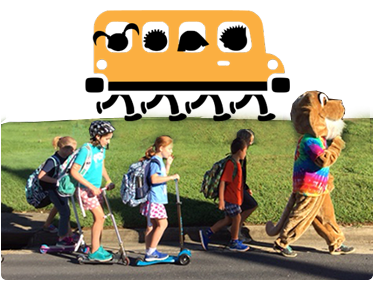
![]()
- Health & Wellness Fair
- Healthy Living Resource Folder
(Google Drive)

- [email protected]
- Twitter: @fcpssrts1
Safe Routes to School
-
Educate students on pedestrian and bicycle safety. -
Help students reach the recommended 60 minutes of daily physical activity. -
Help students arrive at school energized and ready to learn. -
Reduce traffic around schools. -
Improve air quality around schools.
![]()
Walk to School Day
 International Walk to School Day is a global event that involves communities from more than 40 countries walking and biking to school on the same day. It began in 1997 as a one-day event. Over time, this event has become part of a movement for year-round safe routes to school and a celebration – with record breaking participation – each October. Today, thousands of schools across America – from all 50 states, the District of Columbia, and Puerto Rico – participate every October. FCPS had the highest number of schools participating last year in the U.S. Plan an event.
International Walk to School Day is a global event that involves communities from more than 40 countries walking and biking to school on the same day. It began in 1997 as a one-day event. Over time, this event has become part of a movement for year-round safe routes to school and a celebration – with record breaking participation – each October. Today, thousands of schools across America – from all 50 states, the District of Columbia, and Puerto Rico – participate every October. FCPS had the highest number of schools participating last year in the U.S. Plan an event.
Bike to School Day
 May is Bike Month and Bike to School Day is the first Wednesday in May. FCPS was had the third highest number of schools participating in Bike to School Day last May. BTSD is an event that highlights the importance of bicycling as a fun, healthy, and safe way to get to school and around town. Participating in National Bike to School Day and hosting an event is a great way to teach safe bicycling skills and encourage biking. Use the momentum of your BTSD event to encourage bicycling and walking to school on a regular basis. Schools can help their students get ready for biking to school by hosting a bike rodeo prior to the event. Planning involves making sure students have a safe route, room to park their bike once they get to school, informing parents and the community of upcoming events.
May is Bike Month and Bike to School Day is the first Wednesday in May. FCPS was had the third highest number of schools participating in Bike to School Day last May. BTSD is an event that highlights the importance of bicycling as a fun, healthy, and safe way to get to school and around town. Participating in National Bike to School Day and hosting an event is a great way to teach safe bicycling skills and encourage biking. Use the momentum of your BTSD event to encourage bicycling and walking to school on a regular basis. Schools can help their students get ready for biking to school by hosting a bike rodeo prior to the event. Planning involves making sure students have a safe route, room to park their bike once they get to school, informing parents and the community of upcoming events.
Year-Round Biking and Walking
For most communities, a one-day event is not enough. Parents, children, teachers and elected officials all see the promise of healthier, happier students; quieter, cleaner and safer streets; and more connected neighborhoods. In the end, walk and bike to school events are about changing community culture. In the process, they build an environment that’s more inviting for every walker and bicyclist, young or old.
Some events are already a strategic part of long-term efforts to promote safe walking and bicycling every day, called Safe Routes to School programs. If you’re looking to transition to ongoing activities, you’re in good company: more than half of walk and bike to school events are part of larger efforts toward walking and bicycling to school. Many of our FCPS schools have weekly or monthly walk/bike to school days.
Walking school buses, mileage tracking, bicycle trains and bicycle skills clinics, and are all ways to keep families excited about walking and bicycling to school.

A Walking School Bus
Studies show that fewer children are walking and biking to school, and more children are at risk of becoming overweight. Changing behaviors of children and parents require creative solutions that are safe and fun. Implementing a walking school bus can be both. A walking school bus is a group of children walking to school with one or more adults. That may sound simple, and that is part of the appeal. It can be as informal as two families taking turns walking their children to school or as structured as a planned route with meeting points, a timetable and a schedule of trained volunteers.
Bike Train
A bike train is a group of students and adults who bicycle to school together, making stops along a previously designated route to pick up others as they approach the school. While walking school buses (the walking version of a bike train) are great for shorter distances, bike trains allow children who live farther from the school to participate, giving students an outlet for regular physical activity while providing a social opportunity for parents and students to connect outside of school hours. Not to mention they also allow students to hone their bicycle safety skills under adult supervision. Organizing a bike train can be formal, involving the school community in a program with several bike trains, or informal, with just you and your neighbors riding to school together - just make sure that everyone is having fun!
Allows children the opportunity to work with a “team”
- Gives opportunity to kids to practice their bicycle safety skills under adult supervision
- Reduces traffic congestion during school arrival and departure
- Provides an opportunity to get to know neighbors and build community
- Improves personal safety by adding more eyes and ears on the street
- Most importantly…it’s fun
Bike Rodeo
Bike rodeos are designed to help children who already know how to ride develop safety skills under the guidance of veteran cyclists. Youth are given an opportunity to learn real-life bicycle-handling skills that enable them to safely ride in neighborhood areas: braking, balancing, basic road rules, and how to handle obstacles. The FCPS Safe Routes to School office can help you plan a rodeo for your students.
